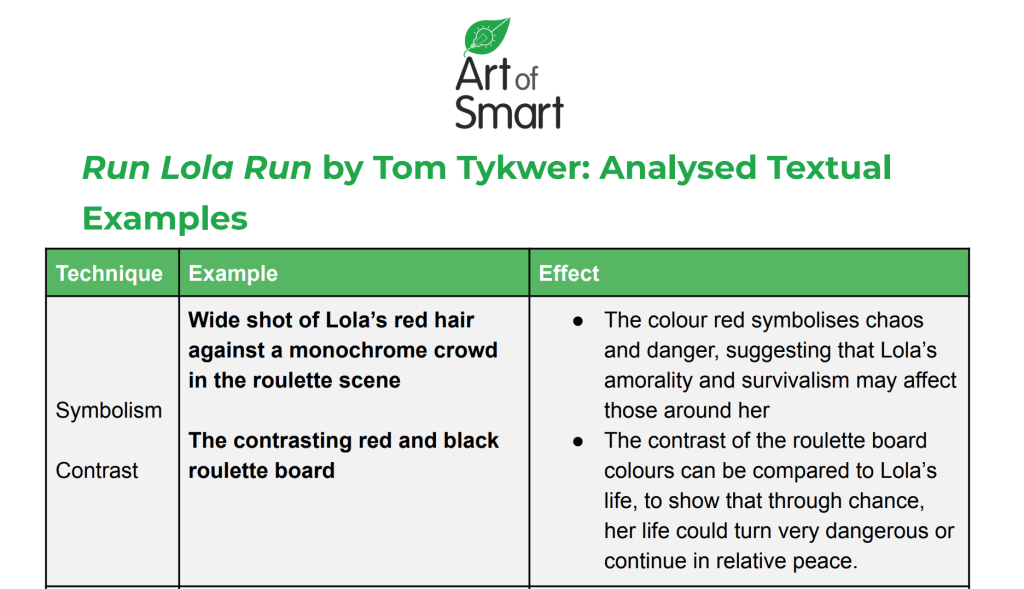Feeling stressed because you aren’t sure how to tackle your essay analysis of ‘Run Lola Run’? Well we’re here to make things easier for you by running through the themes, key characters, context and a summary of Run Lola Run to help you write a fantastic essay!
You’ll even be able to download a table with examples of analysis (also called a TEE table) and a sample paragraph that receives high marks.
Keep reading to ace your analysis of Run Lola Run!
Run Lola Run Summary
Key Characters in Run Lola Run
Context
Themes Explored in Run Lola Run
Analysis of Run Lola Run
Summary of Run Lola Run
Run Lola Run is a 1998 German film written and directed by Tom Tykwer. This experimental thriller follows the story of Lola who has just 20 minutes to find 100,000 Deutschmarks to save the life of her dodgy boyfriend, Manni.
Lola’s first run
At the start of the film, Manni calls Lola to explain that he left 100,000 Deutschmarks on a train after he saw guards. It’s a lot of money, and Manni is responsible for delivering all that cash as part of an illegal plan.
To complicate things more, Manni is supposed to meet his boss Ronnie in 20 minutes and if Manni doesn’t have the money, Ronnie will kill him. Manni plans to rob a local supermarket out of desperation so he can deliver the funds.
Lola’s father is a bank manager, so she hurries to see him and ask for help. While at the bank, Lola bumps into her father’s mistress, who says she is pregnant. Lola’s father suddenly informs her that he and Lola’s mother are getting a divorce, and Lola is not his biological daughter.
Without the money she expected to secure, Lola joins Manni to rob the supermarket. When they come out, they find the store surrounded by police.
Manni surrenders, throwing the money into the air. A startled police officer accidentally fires his gun. As a result, Lola is shot dead.
A second twist
However, that’s not the end of the movie. The plot restarts from the time Lola first left the house. This time, Lola trips over a man and his dog in the park whom she had previously ignored.
Lola arrives late to the bank, allowing her to hear that her father is not the father of his mistresses’ baby. Angry, Lola grabs a gun and holds her father hostage while robbing the banks of 100,000 Deutschmarks.
Police take Lola to be a bystander, so she leaves and reaches Manni just before he robs the supermarket. When she gets there, however, an ambulance runs over Manni and kills him.
Success for Lola and Manni
In the final run of events, Lola sprints over the man and his dog so that she doesn’t trip. She arrives at the bank earlier, but this time her father’s colleague comes to speak to him and he is removed from the bank.
Lola then heads to a casino and plays roulette. She bets on the number 20 and wins. After a few more rounds, she has obtained 129,6000 Deutschmarks and quickly runs to where Manni will meet Ronnie.
Meanwhile, Manni has seen a homeless man passing by with his original bag of money. He steals the bag at gunpoint, in exchange for his gun.
The pair then reunite and Manni hands the money over to Ronnie. Lola still has her cash.
Key Characters in Run Lola Run
Before we look at key characters in this film, it is important to note that ‘Run Lola Run’ isn’t really about the character development of intimacy. Instead, it centres on the plot and small changes amounting in huge consequences.
The characters in this film are essential for driving the story, however the text is not about characters in and of themselves.
You may want to consider this when writing analysis, as it will likely be a little different to other texts you study.
Lola
Played by Franka Potente, Lola is the movie’s protagonist. She’s quick-thinking and witty, though tied up with the wrong people.
Throughout the film, we see several dynamic sides of her character. However, it’s unclear what her true personality is because of altering events.
Manni
Manni is Lola’s boyfriend and a main character in the movie. He is working within a fairly secretive criminal business. Though we don’t see much interaction between him and Lola, it is clear he cares about her and they are a tight team.
Ronnie
As Manni’s boss, Ronnie is the scary antagonist within the movie. We don’t know a lot about his personality. However, he holds great power over Manni’s life and his mental wellbeing. It is through his threats to kill Manni that the story unfolds.
Papa/Lola’s dad
A deceptive bank lender, Lola’s dad provides complications within the story. He is likely wealthy from his career, yet he is distant from his family and strained in his relationship with Lola.
Context of Run Lola Run
Run Lola Run is ultimately about the profound impact that small, spur of the moment decisions can have on life. Creator Tom Tykwer is a self-taught filmmaker who wanted to explore this concept.
Tykwer told IndieWire that he wanted to create a work “to translate the emotional state of people into film language”. It also has references to old art such as Valdes’ portrait in ‘Vertigo’ and camera angles reminiscent of ‘Raiders of the Lost Ark’.
Set in Berlin, this film was made just nine years after the fall of the Berlin Wall, in which the city was no longer divided. Though Tykwer does not cite this as a direct influence, it is essential for understanding the context in which the film was created.
Themes Explored in Run Lola Run
Tykwer uses this film to unpack the complexities of chance VS human nature in a fast-paced, amoral environment. He explores the idea that life and each person’s situations are fluid, often altered by just one tiny movement.
We unpack the various themes in ‘Run Lola Run’ below:
Morality
The theme of morality plays an intriguing role in Run Lola Run. Lola’s actions throughout the film are governed by her amorality. She’s working to save her boyfriend, and quickly. The film doesn’t make a comment on whether or not Lola’s actions are ‘right’.
Similarly, the different outcomes for her father throughout the film centre on his interaction with his mistress and his daughter, rather than on his infidelity or lack of morality.
Chance
Chance and different outcomes is probably the most major theme of Run Lola Run. As we see the three interactions of Lola’s 20 minutes, we see how small movements can make big differences to the outcome of someone’s life.
In this case, it is exaggerated to literally look at life and death. While there is an ‘ideal’ outcome in the final iteration, in which no one is killed, there is a lot of illegal activity and panic to get there, which questions if we really have control over our own wellbeing.
Time
Time is also a key theme in Run Lola Run. The film is set over a very short period of time — just 20 minutes, repeated thrice. Through such a compact period, we see the importance of a persons’ life and the intricacies of a day unfold.
This short span allows us to see each of Lola and Manni’s movements, analysing them for changes and comparing them to our own lives.
The Butterfly Effect
In a similar vein to the theme of chance, Run Lola Run examines the butterfly effect; a theory in which a small, local change can affect an entire system of events.
For example, if Lola didn’t trip over the man and his dog in the second iteration, she wouldn’t have arrived at the bank late and therefore wouldn’t have grown angry with her father like she did. If she hadn’t done this, she may not have had the courage to rob the bank.
How to Analyse Run Lola Run in 3 Steps
Step 1: Choose your Example
When analysing a text, ensure you look for quotes or examples that add to your essay as a whole. Your example needs to be consistent with the context of the text you are examining.
Generally, this would mean looking at a quote. In film, however, you may look at other elements such as sound or mise-en-scène.
For this example, let’s look at the red colour of Lola’s hair in the roulette scene!
You’ll see in the downloadable example paragraph as you keep reading, that red is a prominent colour in the film. This is just one example out of several in the paragraph.
Step 2: Identify your technique(s)
Ensure that the techniques you choose for a quote or scene support your overall argument.
In the above scene, the red colour of Lola’s hair contributes to techniques like contrast, symbolism and pathos (emotion).
For additional visual techniques you may want to write about, check out our list!
Step 3: Write the analysis
When writing an analysis, you need to focus on how your chosen techniques enhance the overall theme you are writing about. Whatever you say needs to support a broader argument!
We know that Lola’s actions throughout the different interactions of her life are amoral — she has no real regard for others, yet she isn’t out to get them either. Her life in these 20 minutes is about survival.
As a result, Lola brings an element of chaos and danger to the rooms she enters, which is symbolised by her red hair.
And there you have it, a comprehensive analysis of ‘Run Lola Run’. As you work through this film, you may find it helpful to read up on German works from a similar period, or discuss your essay ideas with your teacher more closely.
Need some help analysing other texts?
Check out other texts we’ve created guides for below:
- Mrs Dalloway
- King Lear
- Hamlet
- Jane Eyre
- In Cold Blood
- To Kill a Mockingbird
- Amélie
- Pride and Prejudice
- Jasper Jones
- One Flew Over the Cuckoo’s Nest
- Macbeth
- Persepolis
Are you looking for some extra help with studying English?
We have an incredible team of English tutors and mentors!
We can help you master your analysis of your English text by taking you through its summary, key characters and themes. We’ll also help you ace your upcoming English assessments with personalised lessons conducted one-on-one in your home or online!
We’ve supported over 8,000 students over the last 11 years, and on average our students score mark improvements of over 20%!
To find out more and get started with an inspirational English tutor and mentor, get in touch today or give us a ring on 1300 267 888!
Lucinda Garbutt-Young hopes to one day be writing for a big-shot newspaper… or maybe just for a friendly magazine in the arts sector. Right now, she is enjoying studying a Bachelor of Public Communication (Public Relations and Journalism) at UTS while she writes on the side. She also loves making coffees for people in her job as a barista, and loves nothing more than a sun shower.







